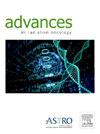Reirradiation of Utracentrally Located Thoracic Tumors Using a 10-Fraction Hypofractionated Stereotactic Body Radiation Therapy Course: A Detailed Dosimetric Analysis
IF 2.2
Q3 ONCOLOGY
引用次数: 0
Abstract
Purpose
There is very little information detailing outcomes and toxicity following reirradiation for ultracentrally located thoracic tumors, and detailed dosimetric data are nonexistent. These data are critical for the safe management of these extremely difficult cases.
Methods and Materials
The records of 15 individuals undergoing 10-fraction hypofractionated stereotactic body radiation therapy for the management of ultracentrally located thoracic tumors between 2009 and 2020 at a single institution were retrospectively reviewed. Treatment outcomes and toxicity were analyzed. A detailed dosimetric analysis of treatment plans and centrally located organs at risk (OARs) from the initial reirradiation and cumulative radiation therapy courses were presented.
Results
At a median follow up of 10 months, the 1- and 3-year overall survival, progression-free survival, and local control were 52% and 28%, 33% and 28%, and 76% and 61%, respectively. Treatment-related adverse events were low, with 5 individuals (33%) developing ≥grade 2 pneumonitis (grade 2 = 4, grade 3 = 1). Dosimetric parameters were not associated with the development of clinically relevant pneumonitis. No adverse events involving central OARs (esophagus, great vessels, and primary bronchial tree) were identified. The median cumulative mean lung dose was 24 Gy equivalent total doses in 2 Gy fractions (EQD2) (range, 10-33 Gy), with a volume receiving 20 G (V20) of 33% (range, 11%-51%). The median esophageal, primary bronchial tree, and great vessel maximum doses (Dmax) were 93.2 Gy (EQD2) (range, 50-148 Gy), 163 Gy (range, 77-204 Gy), and 191 Gy (range, 129-262 Gy), respectively.
Conclusions
The current investigation is the first to provide detailed cumulative dosimetric data from a cohort of patients comprised entirely of ultracentrally located thoracic tumors. Despite unfavorable anatomic tumor location, given an intimate association with critical OARs, delivering an ablative dose with a 10-fraction hypofractionated stereotactic body radiation therapy course can serve as a feasible option for these challenging cases.
使用 10 分次低分次立体定向体放射治疗疗程对胸腔内肿瘤进行再照射:详细剂量学分析
目的有关超中心位置胸部肿瘤再照射后的疗效和毒性的详细资料很少,详细的剂量数据也不存在。方法和材料回顾性审查了 2009 年至 2020 年期间在一家医疗机构接受 10 分次低分次立体定向体放射治疗以治疗超中心位置胸部肿瘤的 15 例患者的记录。对治疗结果和毒性进行了分析。结果中位随访10个月,1年和3年总生存率、无进展生存率和局部控制率分别为52%和28%、33%和28%、76%和61%。治疗相关不良事件较少,5人(33%)发生≥2级肺炎(2级=4,3级=1)。剂量参数与临床相关肺炎的发生无关。未发现涉及中心OAR(食道、大血管和原发性支气管树)的不良事件。肺部累积平均剂量中位数为 24 Gy 等效总剂量,以 2 Gy 为单位(EQD2)(范围为 10-33 Gy),接受 20 G 的体积(V20)为 33%(范围为 11%-51%)。中位食管、原发性支气管和大血管最大剂量(Dmax)分别为 93.2 Gy (EQD2)(范围:50-148 Gy)、163 Gy(范围:77-204 Gy)和 191 Gy(范围:129-262 Gy)。尽管肿瘤的解剖位置不佳,但考虑到肿瘤与临界OAR的密切关系,用10个分次的低分次立体定向体放射治疗疗程提供消融剂量对这些具有挑战性的病例来说是一种可行的选择。
本文章由计算机程序翻译,如有差异,请以英文原文为准。
求助全文
约1分钟内获得全文
求助全文
来源期刊

Advances in Radiation Oncology
Medicine-Radiology, Nuclear Medicine and Imaging
CiteScore
4.60
自引率
4.30%
发文量
208
审稿时长
98 days
期刊介绍:
The purpose of Advances is to provide information for clinicians who use radiation therapy by publishing: Clinical trial reports and reanalyses. Basic science original reports. Manuscripts examining health services research, comparative and cost effectiveness research, and systematic reviews. Case reports documenting unusual problems and solutions. High quality multi and single institutional series, as well as other novel retrospective hypothesis generating series. Timely critical reviews on important topics in radiation oncology, such as side effects. Articles reporting the natural history of disease and patterns of failure, particularly as they relate to treatment volume delineation. Articles on safety and quality in radiation therapy. Essays on clinical experience. Articles on practice transformation in radiation oncology, in particular: Aspects of health policy that may impact the future practice of radiation oncology. How information technology, such as data analytics and systems innovations, will change radiation oncology practice. Articles on imaging as they relate to radiation therapy treatment.
 求助内容:
求助内容: 应助结果提醒方式:
应助结果提醒方式:


